
The New South Wales (NSW) government has approved plans for solar developer Lightsource bp’s proposed 450MW Goulburn River Solar Farm, in the Upper Hunter region.
The AUS$880 million (US$596 million) project, which will cover a 793-hectare site around 28 kilometres southwest of Merriwa, 273km northwest of Sydney, becomes the ninth solar farm and twenty-fifth renewable energy project approved under the Minns Labor government, who became the governing body of NSW in June 2021.
Try Premium for just $1
- Full premium access for the first month at only $1
- Converts to an annual rate after 30 days unless cancelled
- Cancel anytime during the trial period
Premium Benefits
- Expert industry analysis and interviews
- Digital access to PV Tech Power journal
- Exclusive event discounts
Or get the full Premium subscription right away
Or continue reading this article for free
It is worth noting that the project is located between the Central-West Orana Renewable Energy Zone (REZ) and the Hunter-Central Coast REZ, and will have direct access to the existing electricity transmission network. A 500kV overhead transmission line is located in the south-eastern corner of the site.
Via this link, the green energy produced by the solar PV project will be dispatched to the National Electricity Market (NEM), further contributing to the NSW government’s target to halve emissions by 2030 and Australia’s wider 82% 2030 renewable energy target.
Plans for the project detail that it will comprise approximately one million bifacial solar PV modules in an east-west single-axis tracking arrangement, with an approximate height of three metres. It will have an operational lifespan of around 40 years.
Lightsource bp will also provide annual contributions to the Upper Hunter Shire Council at the greater of AUS$346 per megawatt installed, or AUS$190,000 through a Voluntary Planning Agreement.
You can find a layout of the solar-plus-storage project proposal below.

NSW government imposes battery energy storage restriction
Planning documents confirm that the project is also set to include co-located battery energy storage systems (BESS). Indeed, the documents confirm that Lightsource bp is looking to develop a 900MWh centralised BESS or a 2,060MWh decentralised BESS installation.
The project determination states that the centralised BESS unit should not exceed a total energy storage capacity of 900MWh. The total energy storage stored in all decentralised battery storage system locations must not exceed 1,160MWh. These restrictions, however, can be modified with a different development application.
Paul Scully, the NSW minister for planning and public spaces, stated that the project is one of many that will help bolster the state’s growing renewable energy infrastructure and play a role in powering the economy for “generations to come”.
“Under our government, we have a planning system that is supporting the renewable energy transition, approving projects that will support our communities, energy security and emissions reductions,” Scully added.
“With 350 jobs generated during construction and operation, this project will benefit the local economy, local communities and provide indirect benefits to local services throughout the life of project.”






